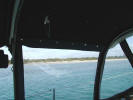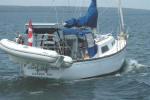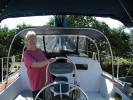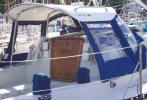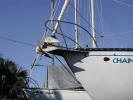The first picture is of the bow roller and bow sprit
that I added. Removed the aluminum stem head fitting and put a stainless one
in its place. The aluminum one had a crack in it. The bowsprit really
makes a difference on deck size.
HARD DODGER
Dodger 1
The full dodger, with the bimini, middle insert and
side panels added. I wanted the dodger high enough that I could stand under
it and still see forward without ducking. 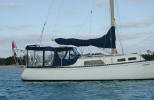 The dodger height is 5' 9" off the cockpit sole. All fabric panels and
plastic can be either removed individually or rolled up out of the way for
maximum ventilation.
The dodger height is 5' 9" off the cockpit sole. All fabric panels and
plastic can be either removed individually or rolled up out of the way for
maximum ventilation.
Dodger 2
Shows the construction method used. I used 1/8 inch
door skins for the material. The skins were cut so that the grain would
run fore and aft. The joints were beveled to 45 degrees and joined to the
section next using thickened epoxy. The skins were cut 4 inches wider that
the finished width of the dodger. The dodger frames were used to form the
mould so that the curvature would be close. Two, two inch wide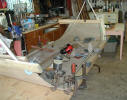 strips of door skin were cut and placed along the outside edges epoxied in
place. The reason for these were to allow the edges to be rounded off and
for an adequate thickness to attach bolts etc. Fiberglass weight was 4 and
6 oz. Only epoxy resin was used
strips of door skin were cut and placed along the outside edges epoxied in
place. The reason for these were to allow the edges to be rounded off and
for an adequate thickness to attach bolts etc. Fiberglass weight was 4 and
6 oz. Only epoxy resin was used
Once the main piece was formed, the edges were rounded off to the final form. The wood was coated with a coat of thinned epoxy and the first layer of glass was applied on the outside. Once it was dry the cloth was lightly sanded and a second layer was applied. The next layer was applied on the inside and then two layers around the edges. Sanded filled an painted.
It was then bolted to the original dodger frames.which were placed in a verticle position and trimmed to the correct height. The front section of the dodger was attached to the cloth using a plastic bolt rope extrusion. Sides were attached using dome fasteners.
Dodger 3
Shows the dodger from behind
Dodger 5
Revery
A picture of the yacht Revery with a dodger made commercially. Cost was just over $4,000 as far as I know
NOTES
The dodger has been in use for 5 years now. No delamination or other deterioration has taken place. It has weathered 50 knot winds and had been through a few waves which covered the deck with over a foot of water. The handrails on the top really make it easy to go forward and the vertical support for the dodger provides a fantastic handhold when climbing into and out of the cockpit. Total weight of the dodger and the pipes holding it is just under 20 lbs. Fabric is extra. I remove it for the winter by undoing 4 bolts, a five minute job. The centre panel of the bimini is removable so that when single handing I can lead the mainsheet to a block mounted on the pedestal. The mainsheet is double ended with the other end led to a cleat on the top of the cabin, starboard side.
